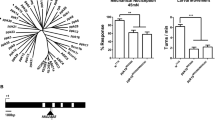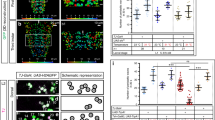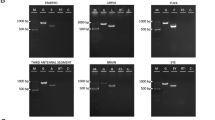Abstract
Single mutations that disrupt basic physiological processes such as axonal conduction and synaptic transmission provide one means to study the membrane components and mechanisms that underlie these processes1,8. Temperature-sensitive paralytic mutants of Drosophila melanogaster which behave normally at a permissive temperature (23–25 °C) but become paralysed at a restrictive temperature (usually 29–37 °C) have been utilized in such studies. An example is napts (no action potential, temperature-sensitive), a recessive second-chromosome mutation that causes paralysis of larvae and adults at 37 °C. Electrophysiological recordings have demonstrated that napts specifically affects a component of axonal membranes5. Here we show that axonal conduction in napts larvae is abnormally sensitive to tetrodotoxin (TTX), a specific blocker of voltage-sensitive sodium channels9, and that the refractory period of action potentials differs from wild type, consistent with the idea that napts alters the function of sodium channels. It is further shown that parats (paralysed, temperature-sensitive), a recessive X-linked mutation1, also specifically disrupts axonal conduction and that the two mutations affect functionally related membrane components. Identification of other mutants defective in associated components of nerve membranes is made feasible by using techniques described here.
This is a preview of subscription content, access via your institution
Access options
Subscribe to this journal
Receive 51 print issues and online access
$199.00 per year
only $3.90 per issue
Buy this article
- Purchase on Springer Link
- Instant access to full article PDF
Prices may be subject to local taxes which are calculated during checkout
Similar content being viewed by others
References
Suzuki, D. T., Grigliatti, T. & Williamson, R. Proc. natn. Acad. Sci. U.S.A. 68, 890–893 (1971).
Grigliatti, T. A., Hall, L., Rosenbluth, R. & Suzuki, D. Mol. gen. Genet. 120, 107–114 (1973).
Ikeda, K., Ozawa, S. & Hagiwara, S. Nature 259, 489–491 (1976).
Siddiqi, O. & Benzer, S. Proc. natn. Acad. Sci. U.S.A. 73, 3253–3257 (1976).
Wu, C.-F., Ganetzky, B., Jan, L. Y., Jan, Y.N. & Benzer, S. Proc. natn. Acad. Sci. U.S.A. 75, 4047–4051 (1978).
Poodry, C. A. & Edgar, L. J. Cell Biol. 81, 520–527 (1979).
Gitschier, J., Strichartz, G. R. & Hall, L. M. Biochem. biophys. Acta 595, 291–303 (1980).
West, G.J. & Catterall, W.A. Proc. natn. Acad. Sci. U.S.A. 76, 4136–4140 (1979).
Narahashi, T. Physiol. Rev. 54, 813–889 (1974).
Jan, L. Y. & Jan, Y.-N. J. Physiol. Lond. 262, 189–214 (1976).
Katz, B. & Miledi, R. Proc. R. Soc. Lond. B167, 23–38 (1967).
Jan, Y.-N., Jan, L. Y. & Dennis, M.J. Proc. R. Soc Lond. B198, 87–108 (1977).
Hardie, J. J. Insect Physiol. 22, 661–668 (1976).
Hardie, J. & Osborne, M. P. Comp. Biochem. Physiol. 57 A, 59–66 (1977).
Kauvar, L. M. CalTech Biol. ann. Report, 154 (1979).
Hodgkin, A. L. & Huxley, A. F. J. Physiol. Lond. 117, 500–544 (1952).
Siddiqi, O. in Regulation of Growth and Differentiated Function in Eukarytoic Cells (ed. Talwar, G. P.) 541–549 (Raven, New York, 1975).
Lucchesi, J. C. Genetics 59, 37–44 (1968).
Author information
Authors and Affiliations
Rights and permissions
About this article
Cite this article
Wu, CF., Ganetzky, B. Genetic alteration of nerve membrane excitability in temperature-sensitive paralytic mutants of Drosophila melanogaster. Nature 286, 814–816 (1980). https://doi.org/10.1038/286814a0
Received:
Accepted:
Published:
Issue Date:
DOI: https://doi.org/10.1038/286814a0
Comments
By submitting a comment you agree to abide by our Terms and Community Guidelines. If you find something abusive or that does not comply with our terms or guidelines please flag it as inappropriate.



